|
Northparkes/Goonumbla, Endeavour, E26, E22, E27, E48 |
|
|
New South Wales, NSW, Australia |
| Main commodities:
Cu Au
|
|
 |
|
 |
 |
Super Porphyry Cu and Au


|
IOCG Deposits - 70 papers

|
All papers now Open Access.
Available as Full Text for direct download or on request. |
|
 |
The Northparkes group of porphyry copper-gold deposits are located some 125 km WNW of the Cadia-Ridgeway deposits and ~30 km NNW of the city of Parkes in the Bogan Gate Synclinorial Zone of the Lachlan Fold Belt in central New South Wales (#Location: 32° 54' 33"S, 148° 2' 32"E [E22-27]). The principal deposits are Endeavour (E) 22, 27, 26, 48 and GRP314, with the smaller E28, E37 and E31. E22 is <1 km west of E27. E26 is 3.5 km to the south. E48 is ~1 km to the south of E22-27, whilst the smaller E28 is between E48 and E26. E37 is ~5 km WSW of E22, and E31 is ~4 km SE of E27.
The Northparkes deposits were discovered in 1977 during a regional program searching for VHMS mineralisation in the Goonumbla Volcanic Complex by GeoPeko, the exploration subsidiary of Peko Wallsend Limited. A program of roadside auger core drilling through thick cover detected patches and disseminations of bornite and chalcocite in a fragmental rock assaying ~0.3% Cu. Followup core drilling intersected 203 m @ 0.66% Cu, 0.77 g/t Au in what was to become the E22 deposit. Further followup located the E20 (in 1977), and E27 and E28 deposits in 1978. In 1980, an intersection of 391 m @ 0.48% Cu testing a geochemical anomaly extending from E26 was the discovery hole for E26. Further regional auger drilling identified many sub-economic porphyry systems. In 1992, testing of a magnetic anomaly similar to that reflecting E26, resulted in the discovery of E48. Since 1999, near mine exploration has outlined five smaller porphyry systems outside of the Northparkes mine lease (Owens, et al., 2017).
In 1988, North Broken Hill Limited (later to become North Limited) took over Peko Wallsend. Development of the deposits was approved by North Limited in November 1992, based on open cut mining of E22 and E27 and underground mining of E26 with a 'Mining Reserve' of 64.1 Mt. The first production was in November 1993 from the E22 and E27 open pits and later from the E26 underground block cave mine in 1996. In October 1993 construction of the E26 underground block cave mine commenced, initially exploiting the orebody from the 480 m level to the base of the E26 open cut, based on a reserve of 28.7 Mt @ 1.45% Cu and 0.39 g/t Au. Construction of the second block cave mine to exploit the orebody from the 830 m level to the base of the first at 480 m was approved in 2001 and commenced in 2004, with an extension, E26 Lift 2 North, in 2008. In 2006 construction commenced on E48 Lift 1, the third major block cave mine, with full production achieved in late 2010, extending the life of Northparkes' operations until 2024. In January 2019, approval was given for the development of a new block cave mine called E26 Lift 1 North (E26L1N), just below the original E26 Lift 1 extraction level to exploit 40 Mt of high grade ore on the southern margin of the original E26 Lift 2 block cave.
The mine was operated by North Limited until 2000, when North was purchased by Rio Tinto Ltd, who then held 80% of the joint venture with Sumitomo Metal Mining Co. In December 2013, the Rio Tinto share of the operation was purchased by China Molybdenum Co., Ltd.
Geological Setting
Like the Cadia-Ridgeway deposits, the Northparkes cluster are associated with a late Ordovician shoshonitic volcano-intrusive centre, in this case, the Goonumbla Igneous Complex. The Northparkes porphyry intrusives are very similar to those at Ridgeway, with the main difference being the relative importance of gold and copper.
The Goonumbla Igneous Complex, is part of the Ordovician to Early Silurian Junee-Narromine Volcanic Belt, a remnant of the Macquarie Volcanic Arc. The complex is divided into three parts (see references in Lickfold et al., 2003), products of the third pulse of volcanism within the arc, namely the:
• Nelungaloo Volcanics, which are 650 to 1500 m thick and are considered to be the oldest. It comprises a subaqueous distal apron facies suite of volcaniclastic sedimentary rocks and syn-sedimentary andesitic lavas and sills (Butera et al., 2001; Simpson et al., 2005). It ended with an ~10 Ma hiatus in volcanism, separating it from the overlying Goonumbla Volcanics. To the east of the Parkes Thrust zone that marks the eastern margin of the Goonumbla Igneous Complex, the Parkes Volcanics are exposed, described by Crawford et al. (2007) as moderately plagioclase-phyric basaltic
andesites and andesites with subordinate augite phenocrysts, that are compositionally distinct from both the Early Ordovician Nelungaloo Volcanics, and the Middle to Late Ordovician Goonumbla Volcanics.
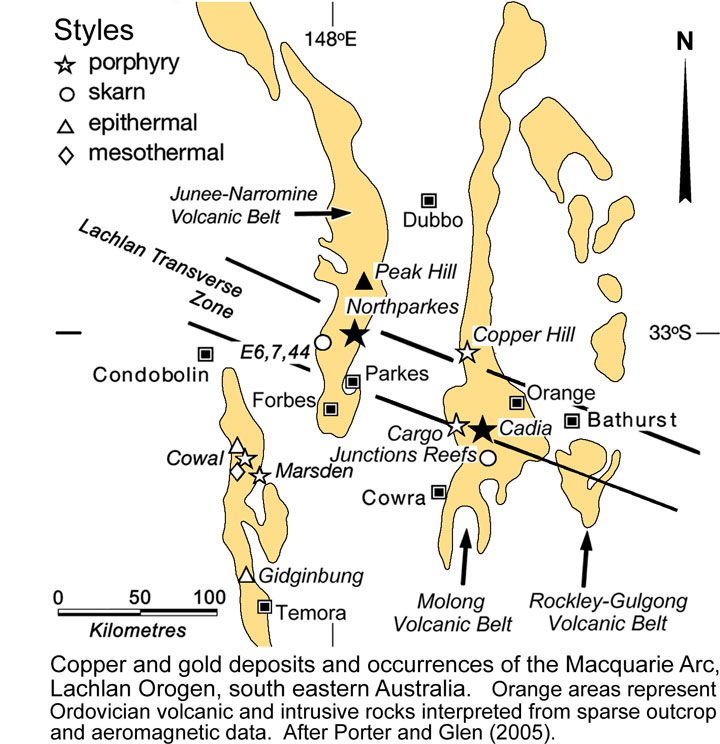
• Goonumbla Volcanics, which are 2500 to 4000 m thick and comprise a Middle to Late Ordovician sequence that commenced with a thick succession of shallow water, bedded volcaniclastic sandstone, siltstone, minor intercalated limestones and volcanic breccia. These were followed by a thick volcanic conglomerate and a coeval sequence of coherent basaltic andesitic to trachyandesitic volcanic rocks, including lavas and shallow sills with peperitic margins. The Billabong Creek Limestone and Gunningbland Formation are interpreted to be lateral equivalents of the Goonumbla Volcanics. The Billabong Creek Limestone comprises discontinuous limestone units with Late Ordovician corals and conodants intercalated with poorly exposed volcaniclastic rocks. The Gunningbland Formation comprises fine sandstones and siltstones containing a diverse fauna of brachiopods, trilobites and nautiloids, and limestone lenses with corals and stromatoporoids. A monzodiorite intrusion cutting the lower sections of the Goonumbla Volcanics has been dated at 450.8±4.2 Ma.
• Wombin Volcanics, which are 700 to 1000 m thick and of Late Ordovician age, are considered to be a proximal-derived volcaniclastic apron facies of polymict volcanic breccias intercalated with turbiditic crystal-rich sandstone and less abundant syn-sedimentary trachyandesitic sills, porphyritic trachyandesitic and flow banded trachytic lavas. They typically include dark red hematite-dusted glassy lavas and ignimbrites and are distinguished by their more evolved chemistry and reddish-brown colour.
Rocks belonging to the Silurian Forbes Group, particularly the Mumbidgle Formation fossiliferous mudstone and lithic mudstone, siltstone, shale and minor sandstone, have been thrust westward over the Goonumbla Volcanics. This thrust sheet includes fault blocks and slivers of the Ordovician to Silurian Cotton Formation composed of fine-grained siltstone, with isolated calcareous horizons containing a shallow-water coralline assemblage, and the Early Ordovician Parkes Volcanics. Further east the andesitic, Late Ordovician to early Silurian Nash Hill Volcanics form a broad NNW-SSE trending fault defined corridor.
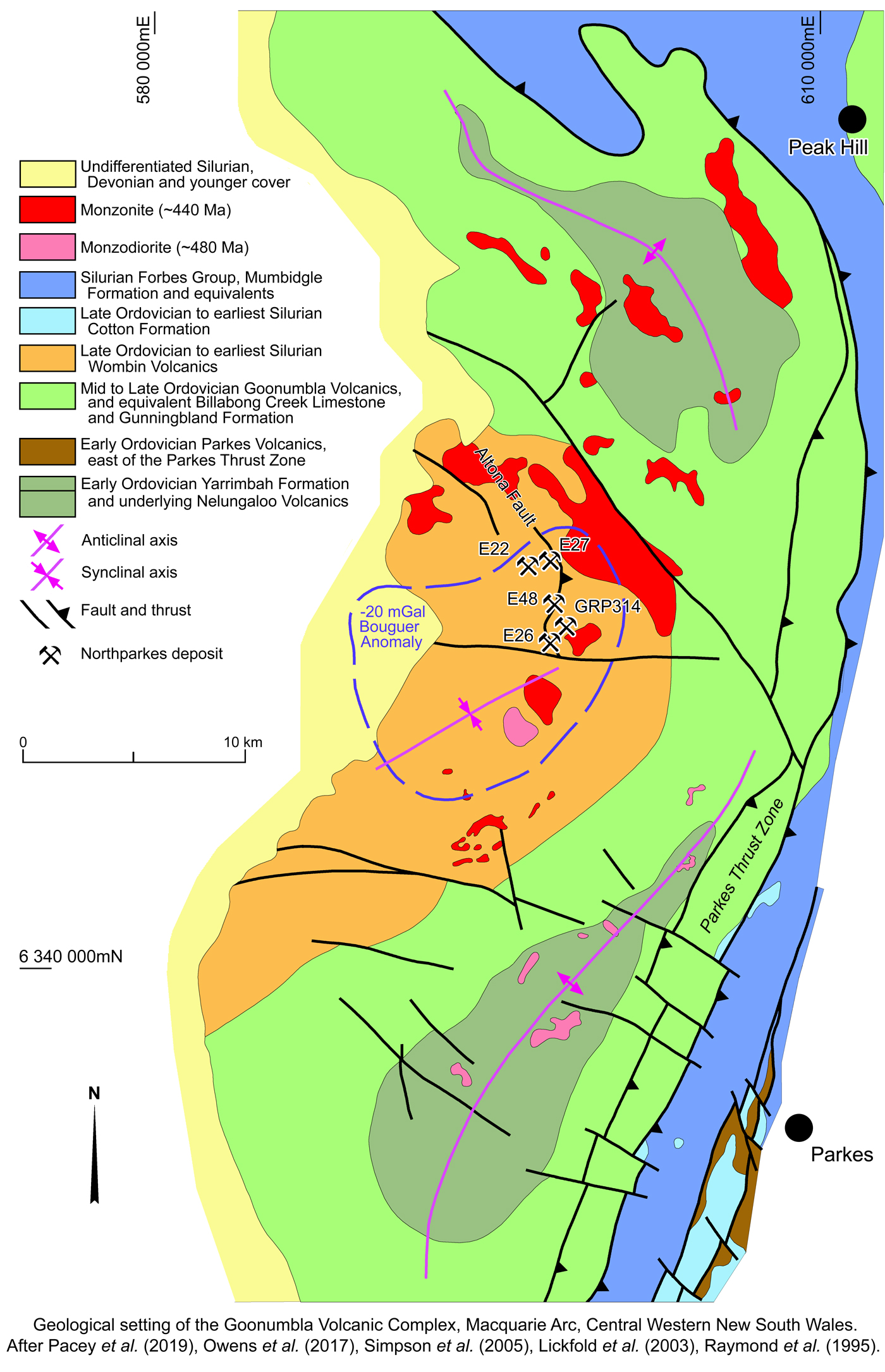
Heithersay and Walshe (1995) interpreted the Goonumbla and Wombin Volcanics to have formed as an ancient volcanic edifice, built on a substrate of Early Ordovician sedimentary and volcanic rocks, which consists of the Nelungaloo Volcanics overlain by the Early Ordovician Yarrimbah Formation. These two units are manifestations of pulse 1 of arc magmatism and consist of andesitic lavas and volcaniclastic sedimentary rocks overlain by an upward fining-sequence of volcanic-derived conglomerate, sandstone and siltstone. Lickfold et al., (2003) quoted Simpson et al., (2000) as having interpreted the Goonumbla and Wombin Volcanics as a 'several kilometre' thick subaqueous volcaniclastic apron that formed on the flanks of a shallow marine, to possibly sub-aerial, largely Late Ordovician strato-volcano. They argue that the ignimbrites and trachytic lavas indicate voluminous explosive eruptions and sector collapse on the subaerial sections of the volcano.
Both the Goonumbla and Wombin Volcanics have been intruded by numerous monzonite and quartz monzonite bodies, including the mineralised quartz monzonite porphyry pipes associated with the Endeavour ore deposits. These intrusions typically have a microcrystalline to aphanitic, dark red K feldspar+quartz groundmass. Dating of two samples of zircon from quartz monzonite porphyries 3 km apart (see Lickfold et al., 2003 for details), yielded ages of 439.1±4.5 Ma and 438.9±4.7 Ma respectively, and dating of white mica alteration from Endeavour 26 returned an age of 439.2±1.4 Ma (Perkins et al., 1990), suggesting the quartz monzonite porphyries and alteration are essentially coeval. Other age data confirm this hypothesis (Lickfold et al., 2003).
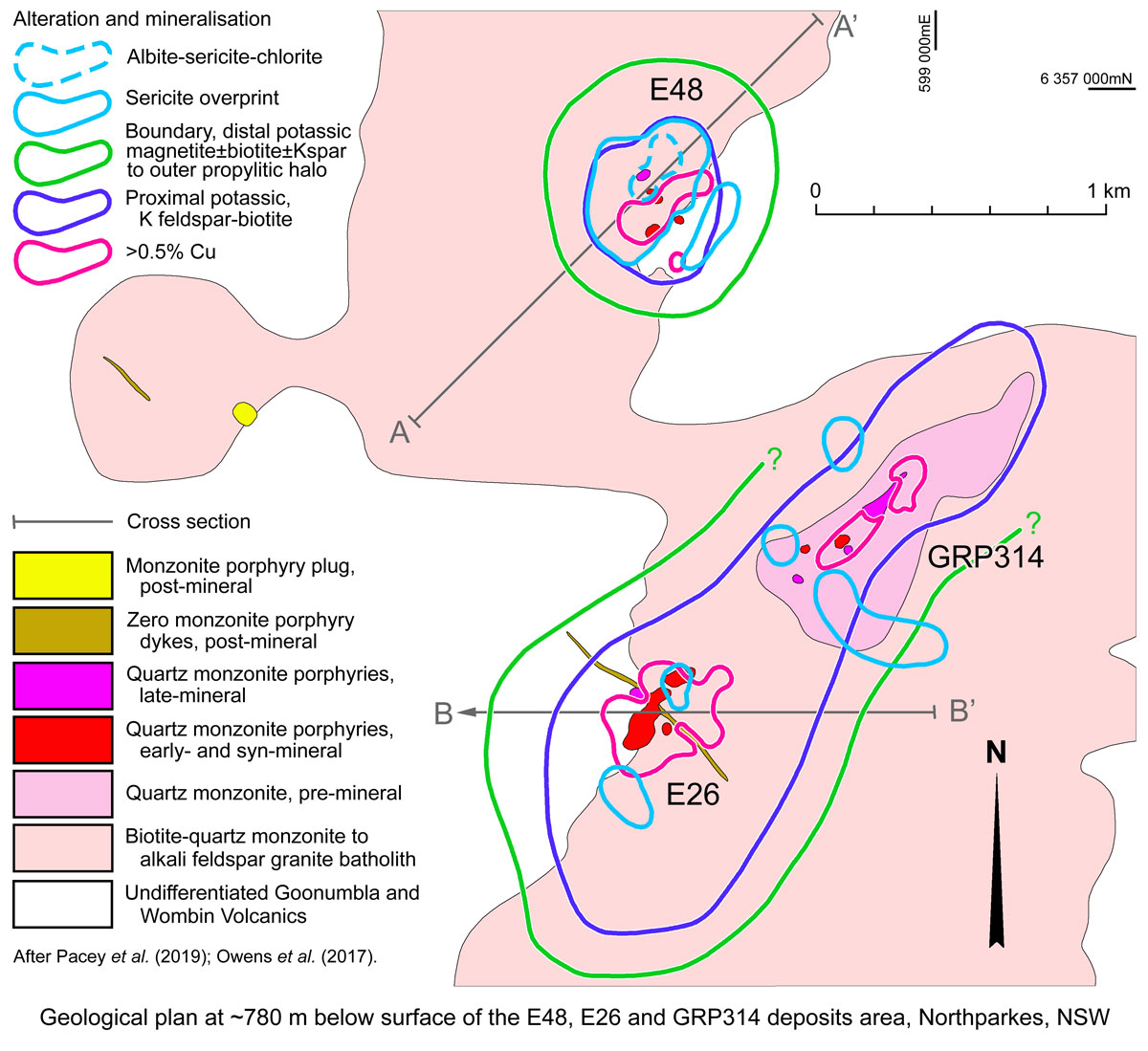
Pre- and syn-mineralisation brittle structures are interpreted to have localised the emplacement of intrusives, including the NNW-trending Endeavour Linear, as well as several other NW- and NE-trending fracture sets. Minor brittle movement on certain post quartz monzonite porphyry structures resulted in mostly small-scale disruption and some dislocation of the Endeavour mineralisation (Lickfold et al., 2003).
All of the deposits in the Northparkes (Goonumbla) area are confined to an elliptical, 10 to 20 km diameter, geologic, aeromagnetic and gravity feature interpreted by Heithersay and Walshe (1995) to represent a palaeo-caldera collapse structure associated with the volcanic edifice. The same authors suggested the widespread intrusive monzodioritic to monzonitic pipes related to the Wombin Volcanics were subvolcanic intrusions, emplaced in structures around the rim of the caldera during a subsequent period of resurgent magmatism. However, Simpson et al. (2005) found no evidence to support the existence of a caldera collapse and concluded that the Ordovician source volcanoes were complex stratovolcanoes.
The host Goonumbla volcanic suite described above, range from K-rich basalts to trachyandesites to hyaloclasites and volcaniclastics, and compositionally from shoshonites, through latites to trachytes. Overlying the Goonumbla volcanics, the K trachytes of the Wombin Volcanics also host mineralisation. Most of the ores however are within dark grey latites and sediments of the Goonumbla Volcanics. A suite of intrusives ranging from gabbro through monzonite (adamellite) to syenite cut the volcanics.
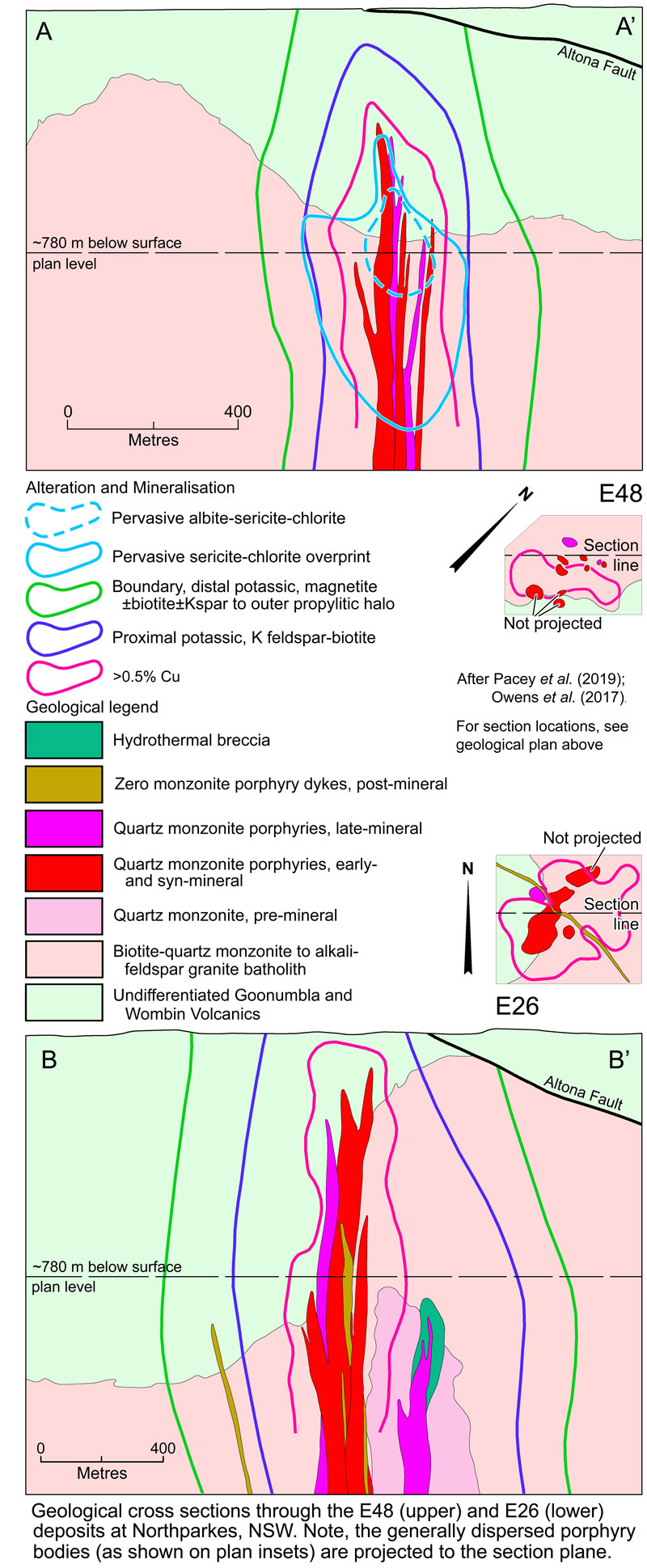
Intrusions
Mineralisation is intimately associated with narrow pipes of quartz-monzonite porphyry (QMP) that are usually satellites of a larger buried monzonite mass. Reserves have been outlined for 4 significant and at least 8 lesser centres of mineralisation. The ore deposits are also generally pipe like with a strong vertical continuity. Lickfold et al., (2003) described the Endeavour deposits as being concentrically zoned, cylindrical bodies of quartz-sulphide stockwork veining centred on pipe-like, multiphase, QMP complexes. These intrusive bodies have lateral dimensions in the order of 50 to 150 m and a minimum vertical extent of 600 to 900 m. The associated ore zones are up to 400 m in diameter based on a 0.5% Cu equivalent cutoff. The QMP intrusions in all four of the main Endeavour deposits (E22, 27, 26 and 48) have ubiquitous phenocrysts of plagioclase and K feldspar, the former typically rimmed by fine-grained, anhedral K feldspar. They form part of a series of silica-saturated alkaline intrusions that vary in composition from monzodiorite through to alkali feldspar granite that dominate in the deposits. Primary and secondary magnetite are found in all of the intrusive phases, where the primary phenocrysts are distinguished from the secondary specks by their large (>50 µm) euhedral shape. Similarly, both primary and secondary biotite are also present in all intrusive phases. Apatite, sphene and lesser zircon are accessory micro-phenocrysts in most intrusions (Lickfold et al., 2003).
The Northparkes deposits and associated intrusions all lie along the eastern edge of a large -20 mGal Bouger anomaly that offsets the regional north-south trend in the district. This gravity low has been interpreted to represent a more resistive early BQM pluton/stock around which the surrounding rocks have been wrapped. The bulk of the Northparkes deposits are also distributed along the boundary between a local magnetic high and a detextured lower magnetic intensity zone. This has been interpreted to represent the interplay between magnetite addition associated with potassic magnetite-biotite alteration and magnetite destruction in the intense K feldspar altered core of the system, as described below (Owens, et al., 2017).
Lickfold et al., (2003) have recognised and described at least nine intrusive phases within the complexes that are associated with the Endeavour deposits, divided into pre-, early-, syn-, late- and post-mineral intrusions, as follows:
• Pre-mineral Intrusions - represented by a more extensive, equigranular monzodiorite which is found at deeper than 1300 m beneath the surface at Endeavour 26 and in outcrop 500 to 1000 m to the north. It contains 10 to 20% mafic minerals, including, in decreasing order of abundance: augite, biotite, magnetite and hornblende. K feldspar is intergrown with quartz, while rarely, primary(?) anhydrite is interstitial to plagioclase phenocrysts. No primary disseminated sulphides or quartz-sulphide veins are recorded within this lithology, although sericitised clasts of it are found in the biotite quartz monzonite (Lickfold et al., 2003).
• Early-mineral Intrusions - which are biotite quartz monzonites (BQM) that are found adjacent to, or beneath, each of the four deposits at depths of more than 650 m below surface. They are the most voluminous intrusive phase and commonly brick red in colour, medium- to coarse-grained, and equigranular to semi-porphyritic, with 1 to 2 mm euhedral plagioclase, K feldspar and biotite crystals, and interstitial, fine-grained granular subhedral K feldspar, anhedral quartz and minor (<1%) anhydrite. Blebs of disseminated bornite, chalcopyrite and rarely chalcocite are found within the BQM at Endeavour 26, 27 and 48, as are minor 2 to 5 mm thick, straight walled quartz-sulphide veins with K feldspar±biotite selvages. QMP complexes were emplaced on the shoulders of apophyses to the BQM stock ate E22, 27, 26 and 48, whilst at GRP314 the QMP are emplaced within the centre of the BQM body (Owens et al., 2017)
The first of the three varieties of QMP that comprise the 50 to 200 m diameter complexes central to each if the Endeavour deposits are the early, volumetrically minor biotite quartz monzonite porphyry (B–QMP) intrusions. They comprise un-crowded (20 to 30% phenocrysts) to crowded (50 to 60% phenocrysts) porphyritic rocks containing plagioclase, K feldspar, biotite, augite and magnetite phenocrysts in an aphanitic to fine-grained granular groundmass of K feldspar and quartz, typically with around 5% quartz. Fine (10 to 50 µm) copper sulphides (~1%) are disseminated through the groundmass with coarse (11 to 80 mm) clots of bornite and chalcopyrite and minor (usually <1%) bornite-quartz veins in some deposits.
• Syn-mineral Intrusions - primarily represented by K feldspar quartz monzonite porphyry intrusions (K-QMP, the second of the QMP phases), ranging in colour from pale to salmon pink to dark orange-red. It occurs in the central parts of the QMP complexes at all four Endeavour deposits and is volumetrically the most abundant phase. The hydrothermal alteration zones and high-grade ore at each deposit are centred on, and most intensely developed within, the K-QMP and the immediately adjacent volcanic rocks. Disseminated sulphides generally account for about 2%, and stockwork veins 5 to 20%, of the volume of the K-QMP respectively, although the density of veining diminishes in intensity with distance from the outer margin of the intrusive. K-QMP intrusions have an uncrowded porphyritic texture with 30 to 40% phenocrysts of plagioclase, K feldspar and minor (<2%) magnetite +biotite +hornblende, set in a mainly aphanitic K feldspar-quartz groundmass.
• Late-mineral Intrusions - represented by dark orange-red augite-biotite-K feldspar quartz monzonite porphyry intrusions (KA-QMP, the third of the QMP phases) are found over much of the vertical extent of the four deposits, close to both the syn-mineral K-QMP and the following late-mineral B-QMP (see below). The KA-QMP intrusions are volumetrically the second most abundant intrusive phase and have a markedly diminished level of associated alteration and copper-gold mineralisation compared to the K-QMP. In addition, veins within K-QMP intrusions are truncated at the mutual contacts with KA-QMP. Certain of the KA-QMP examples contain xenoliths of volcanic rocks that have truncated quartz veins and clasts of the K-QMP phase. The KA-QMP intrusions are uncrowded to crowded porphyries with plagioclase, K feldspar and minor augite +biotite +magnetite +hornblende phenocrysts set in a fine-grained groundmass ranging from 10 to 50%, averaging 30 to 40% quartz. Bornite and chalcopyrite comprise up to 1% as disseminations through the groundmass. Mineralised quartz veins, with or without central K feldspar cores, locally comprise 5 to 10% of the KA-QMP in all four deposits.
A second, but late-mineral phase of the biotite quartz monzonite porphyry (B-QMP), which followed the KA-QMP, is texturally and geochemically indistinguishable from the early-mineral intrusive with the same designation, although a late mineral timing is indicated by vein truncation where it cuts the K-QMP at Endeavour 22 and 26. At Endeavour 27 however, this latter intrusive phase is only found outside of the complex.
• Post-mineral Intrusions - are present in volumetrically minor amounts and include dykes of basaltic trachyandesite, mafic monzonite porphyry and basalt. The most significant of these are the “Zero Porphyry” dykes, so named because of their very low (‘zero’) metal contents. These brownish-red, crowded (40 to 50%) porphyries contain K feldspar, augite +biotite +hornblende and anhydrite phenocrysts in an aphanitic groundmass of predominantly (~95%) K feldspar. Where trachyandesite dykes are present, they occur at the edges of the Zero Porphyries.
Several basaltic dykes around 1 m thick were emplaced at some of the deposits. The exact age of these dykes is unknown, although some may have intruded the porphyry complexes during the waning stages of volcanism associated with the Goonumbla Volcanic Complex: others may be Tertiary in age.
Mineralisation
Mineralisation occurs as disseminated and quartz vein stockworks, both within the intrusives and the surrounding wall rocks. The strongest grades are associated with quartz vein stockworks developed within the central potassic alteration zone, decreasing outwards as the vein and fracture density decreases. The mineralisation in individual deposits is controlled by the size of the intrusive and the intensity of alteration. In general each deposit has a high grade bornite (and lesser chalcocite) core which passes outwards into a chalcopyrite dominant zone to an outer patchy pyritic (up to 3%) halo. Intense mineral destructive alteration is generally absent, with the potassic core being present as pink-red K feldspar fractures and vein selvages. In zones of intense fracturing and veining these selvages merge. Weak pervasive biotite is also developed in the potassic core. The potassic core, greatest vein density and highest grade are centred on the intrusive pipes. Widespread pervasive, often intense, quartz-sericite-pyrite alteration is semi-regional related to major structures, and not individual deposits, with a regional propylitic phase. Copper:gold ratios are variable across the field, ranging from 1:1 (Cu%:Au g/t) to others where gold is much less abundant.
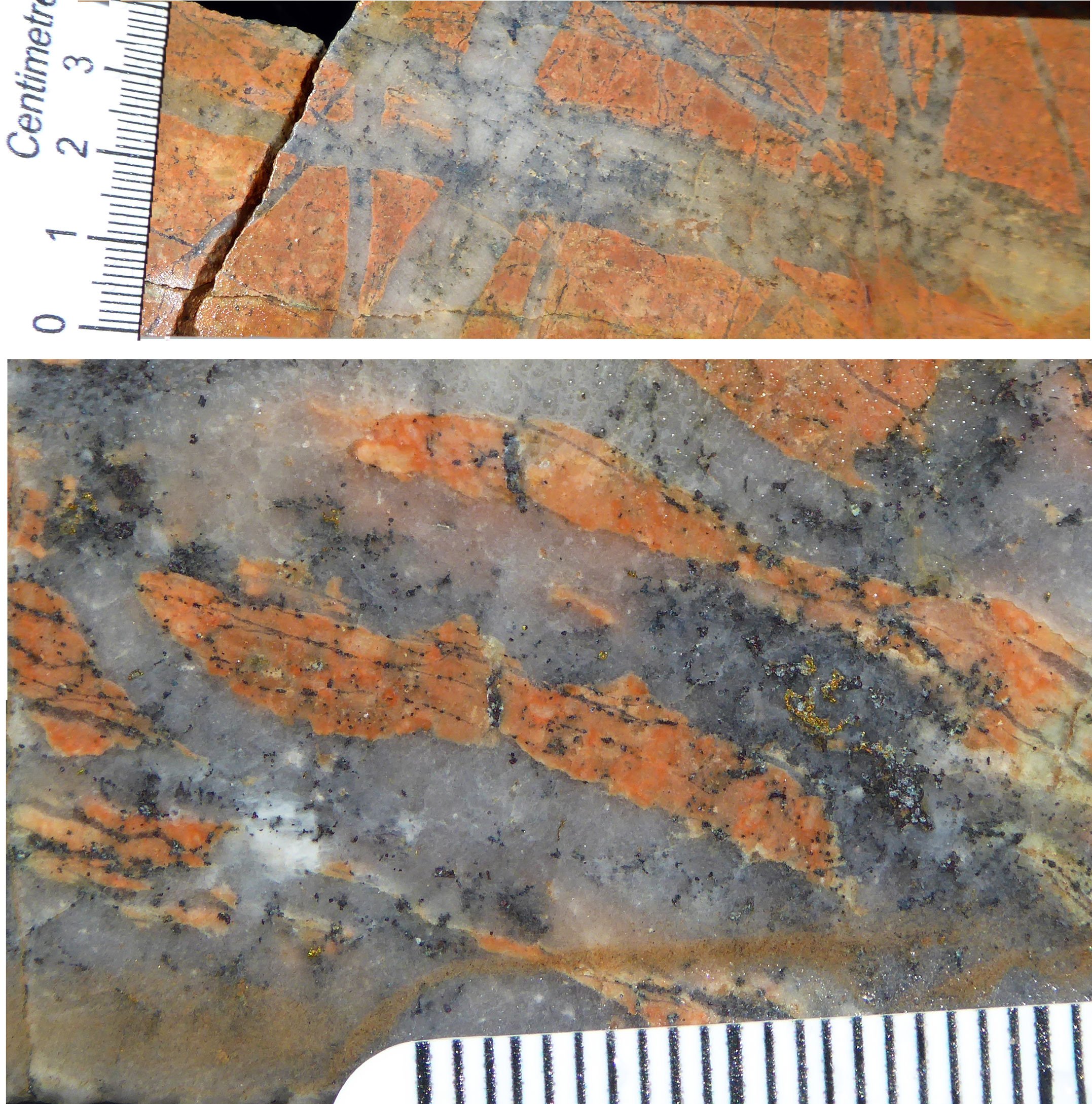
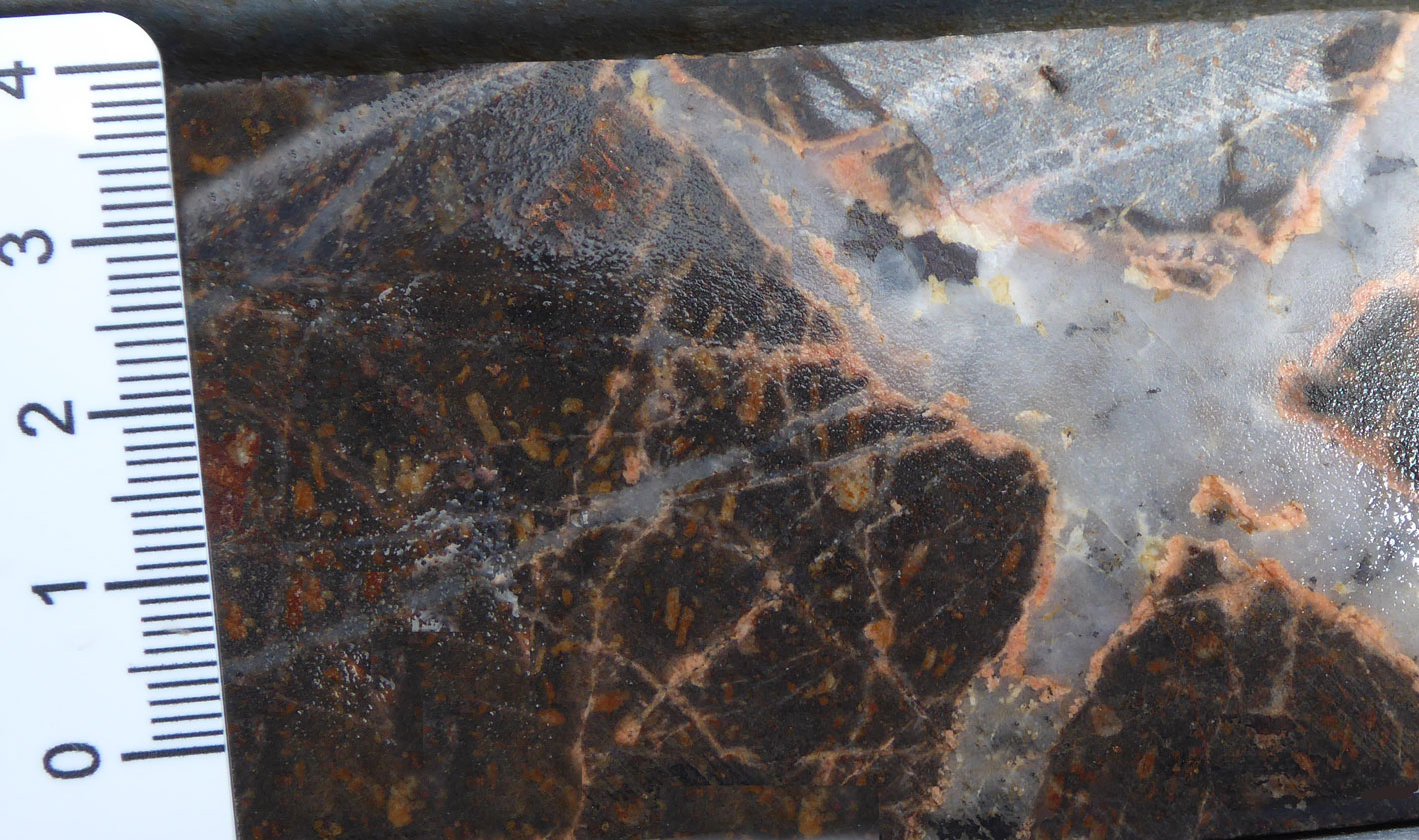
Northparkes mineralisation - the upper image illustrates the distribution of veining within the predominantly K feldspar altered K feldspar quartz monzonite porphyry within the core of the deposit; whilst the middle image is a close-up showing the distribution of sulphides within the veins and host rock, predominantly bornite (dark crystals) with lesser chalcopyrite - scale graduation is in millimetres. The lower image shows veining and potassic alteration that includes K feldspar as veins, selvages to the quartz vein stockwork and fractures, and biotite patches and darkening of the andesitic volcanic country rocks. Note: the upper-right quarter of the lower image is of the same lithology as the left half, but is dry. Images by Mike Porter, 2019, of drill core at Northparkes.
Hydrothermal alteration and mineralisation at each of the four Endeavour deposits are centred on the QMP intrusive pipes and generally do not persist beyond 750 m from the margins of the intrusive complexes into the surrounding volcanic rocks (Lickfold et al., 2003).
The sulphides in each of the mineralisation stages of the Endeavour ore deposits, as described below, are zoned outwards from the cores of the QMP intrusive complexes. They grade from proximal bornite-rich zones, to intervals with equal amounts of bornite and chalcopyrite, to chalcopyrite-dominant, to distal pyrite-dominated assemblages. Gold is typically present as <25 µm inclusions along fractures within bornite grains, along bornite grain boundaries, and on rare occasions, as inclusions in chalcocite. Silver is also found in association with bornite, with average grades of between 3 and 4 g/t in each of the four deposits. Bornite and chalcocite are intergrown where they are found together, while chalcopyrite occurs either along fractures and cleavage planes within bornite, or as mutual intergrowths where the two minerals coexist. Minor tellurides, selenides, tennantite-tetrahedrite and enargite are found as inclusions in bornite and chalcopyrite, as intergrowths in bornite, and less commonly in chalcopyrite and chalcocite. In the main stage veining, bornite and chalcopyrite are intergrown with anhydrite. Bornite also occurs as clots in the B-QMP, K-QMP and KA-QMP at each of the Endeavour deposits, generally accounting for <1% of the total sulphides. These clots are spherical to irregular in shape and contain ~98% bornite, with only traces of the other sulphides and silicates. They have no obvious connection with veining and occur in rocks that have been overprinted by K-silicate alteration only; sericite alteration assemblages are absent (Lickfold et al., 2003).
Lickfold et al., (2003), and authors cited therein, noted that alteration assemblages are generally both discontinuous and non-symmetrical, and vary from deposit to deposit due to the multiplicity and geometry of intrusion and alteration/ mineralisation. They also point out that while the pattern at each deposit is therefore unique, there are common features that have combined to produce the overall result, as summarised below.
• Pre-mineral Stage - an early halo of vein-like K feldspar +quartz dykes containing weak copper mineralisation appears to predate early K-silicate alteration and possibly to have been related to the BQM intrusions. Pre-mineral weak to intense alteration occurs mainly in the volcanic wall rocks and BQM intrusions and comprises albitisation and sericitisation of plagioclase and K feldspar, as well as alteration of magmatic magnetite to chlorite +quartz +carbonate ±fluorite.
• Early Stage alteration and mineralisation, which followed the pre-mineral stage, resulted in the formation of 50-200 m wide alteration aureoles around all four of the QMP complexes central to the Endeavour deposits. These aureoles contain moderate to intense biotite-magnetite and K feldspar alteration and abundant quartz-sulphide veins at their cores, and grade outwards to epidote-bearing propylitic alteration at Endeavour 48. Inwards, towards the core of the deposits, there is a transition from biotite +magnetite to K feldspar, characterised by K feldspar ±anhydrite ±magnetite alteration assemblages, hematite dusting of the wall rocks, and irregular discontinuous veins of quartz +K feldspar, ±biotite ±chalcopyrire ±bornite ±magnetite ±anhydrite ±calcite. This alteration assemblage and veining is interpreted to have accompanied the early-mineral B-QMP intrusions.
• Transitional Stage, unidirectional solidification textures (continuous to discontinuous alternating bands of comb quartz and aplite porphyry containing disseminated sulphides and occasional, plagioclase and/or K feldspar phenocrysts) and related anisotropic textures (such as miarolitic cavities, spherical aggregates of quartz and K feldspar) occur in both the K-QMP and KA-QMP phases. They have been interpreted to have accompanied each phase as discrete "magmatic to hydrothermal" transition episodes.
• Main Stage M1 and M2 veins, associated with the K-QMP and KA-QMP intrusives respectively, were responsible for the main episodes of mineralisation in the Endeavour deposits. The bulk of the sulphide mineralisation in all four deposits occurs in the M1 veins, which vary in character with time. Early M1 veins have K feldspar halos, while those emplaced later are fringed by sericitehematite. Early M1a veins and veinlets are thin (<10 mm) and comprise quartz+sulphide+K feldspar ±anhydrite ±calcite ±apatite ±rutile with thin (<5 mm) quartz-K feldspar selvages. The M1b stockwork or sheeted veins, which are characteristically linear and vary from 5 to 20 mm in thickness, comprise quartz +sulphide ±anhydrite +carbonate +K feldspar, enclosed by a halo of pervasive, locally mottled, sericite+quartz±hematite alteration. Minor tetrahedrite-tennantite, covellite, chalcocite, tellurides and/or lead selenides are also found within these veins. M1b veins contain the bulk of the sulphides in the Endeavour deposits. The M1c veins comprise milky quartz +chalcopyrite>bornite +calcite which are found ~50 m outboard of the QMP complexes in volcanic wall rocks; they are characterised by higher calcite and lower quartz, and are enriched in chalcopyrite and bornite compared to M1b veins.
The M2a and M2b stage veins are associated with the KA-QMP intrusive phase in each of the Endeavour deposits and are broadly similar to M1a and M1b, although the M2a and M2b veins carry more chalcopyrite than bornite.
• Late Stage mineralisation and alteration are represented by three sericite alteration assemblages and associated veining, although only one, L1, is strongly mineralised. L1 alteration comprises intense to moderate, pervasive quartz +sericite +carbonate ±hematite replacement of feldspar phenocrysts and groundmass to produce a finegrained mass that preserves the original texture of the host and is best developed in the K-QMP and KA-QMP intrusions in the core of the Endeavour deposits. Chalcopyrite and minor bornite are disseminated in the altered matrix of these intrusive complexes at Endeavour 22, 26 and 27, while chalcocite+bornite+tennantite-tetrahedrite are evenly distributed in the similarly altered groundmass at Endeavour 48. Away from the pervasive alteration, L1 quartz+carbonate+sericite+chalcopyrite and/or pyrite veins are distinguished from other veins by their sericite-carbonate-pyrite selvages.
Late stage L2 alteration takes the form of fracture- and fault-controlled sericite (phyllic) assemblages that contain sericite+carbonate+quartz +pyrite±anhydrite.
L3 veins are less abundant and comprises carbonate +sericite +quartz +gypsum and/or anhydrite+base metal sulphides ±fluorite, with selvages of the same nonmetallic minerals. The base metal sulphides vary widely in quantity and type and are mainly pyrite ±sphalerite ±galena ±chalcopyrite.
• Post-mineral alteration takes the form of weak to moderate propylitic alteration, where feldspars and mafic minerals have been selectively replaced by carbonate ±hematite ±pyrite. This alteration episode overprinted the "Zero Porphyry" dykes.
Conditions of Deposition - Lickfold et al., (2003) reported microthermometric analyses of fluid inclusions from early-, transitional-, main- and late-stage veins, indicating that the Endeavour deposits were formed at depths between 1000 and 1700 m below the palaeosurface, where lithostatic pressure regimes prevailed during early- to main-stages, and near hydrostatic during late-stage events. They note that the data suggest the early-, transitional- and main-stages were subjected to high temperature (460 to 550°C) magmatic-hydrothermal fluids with salinities of ~55 to 60 wt.% NaCl±KCl equivalent. Although the late stage fluids were cooler (350 to 450°C) and less saline (~40 wt.% NaCl equiv.), their compositions are consistent with magmatic-hydrothermal origins. They conclude that the Endeavour porphyry deposits are representative of the orthomagmatic end member of the porphyry continuum.
Reserves, Resources and Production
The operation has included both a number of open pits and underground block caving mines.
In 1999 reserves totalled 75 Mt @ 1.2 to 1.3% Cu, 0.4 to 0.8 g/t Au, and a resource of 110 Mt @ at similar grades.
In 2012, remaining underground ore reserves and mineral resources were (Rio Tinto, 2013):
Proved reserve (open pit & stockpiles) - 8.2 Mt @ 0.40% Cu, 0.24 g/t Au;
Proved reserve (underground) - 66 Mt @ 0.80% Cu, 0.28 g/t Au;
TOTAL reserve - 74.2 @ 0.76% Cu, 0.27 g/t Au;
Measured resource - 14 Mt @ 0.91% Cu, 0.30 g/t Au;
Indicated resource - 3.7 Mt @ 0.71% Cu, 0.13 g/t Au;
Inferred resource - 271 Mt @ 0.55% Cu, 0.26 g/t Au;
TOTAL resource - 288 @ 0.57% Cu, 0.26 g/t Au.
Note: resources are additional to reserves.
Resources in the smaller E28, E31 and E37 deposits at a 0.3% Cu equiv. cutoff, after Jones, 1985, were:
E28 - 8.1 Mt @ 0.35% Cu, 0.04 g/t Au;
E31 - 6.6 Mt @ 0.35% Cu, 0.39 g/t Au;
E37 - 6.8 Mt @ 0.66% Cu, 0.02 g/t Au.
JORC compliant resources and reserves in 2014 were (China Molybdenum, 2015 web page):
Reserves of 107.5 Mt @ 0.61% Cu, 0.26 g/t Au (=0.81% Cu equivalent)
Measured + indicated resources of 471 Mt @ 0.56% Cu, 0.18 g/t Au (=0.70% Cu equivalent)
JORC compliant resources and reserves at 31 December 2018 were (China Molybdenum, 2018 Annual Report):
Reserves of 140.27 Mt @ 0.55% Cu, 0.21 g/t Au;
Measured + indicated resources of 605.0 Mt @ 0.55% Cu, 0.19 g/t Au.
Production in 2018 comprised 39 900 t Cu and 7.88 t Au in concentrate (China Molybdenum, 2018 Annual Report).
For more detail consult the reference(s) listed below.
The most recent source geological information used to prepare this decription was dated: 2012.
Record last updated: 7/1/2015
This description is a summary from published sources, the chief of which are listed below.
© Copyright Porter GeoConsultancy Pty Ltd. Unauthorised copying, reproduction, storage or dissemination prohibited.
E22 (west) and E27 (east) E26
|
|
|
|
|
Blevin P L 2002 - The petrographic and compositional character of variably K-enriched magmatic suites associated with Ordovician porphyry Cu-Au mineralisation in the Lachlan Fold Belt, Australia: in Mineralium Deposita v37 pp 87-99
|
Cooke D R, Wilson A J, House M J, Wolfe R C, Walshe J L, Lickfold V and Crawford A J, 2007 - Alkalic porphyry Au - Cu and associated mineral deposits of the Ordovician to Early Silurian Macquarie Arc, New South Wales: in Australian J. of Earth Sciences v.54, pp. 455-463.
|
Forster, D.B., McInnes, P., Downes, P.M., Maas, R., Norman, M. and Blevin, P.L., 2015 - New lead isotopic and geochronologic constraints on mineralisation in the Macquarie Arc - insights from the Lake Cowal district, New South Wales: in Geological Survey of New South Wales, Quarterly Notes, No. 144, August, 2015, pp. 2-23.
|
Glen, R.A., Crawford, A.J. and Cooke, D.R., 2007 - Tectonic setting of porphyry Cu - Au mineralisation in the Ordovician - Early Silurian Macquarie Arc, Eastern Lachlan Orogen, New South Wales: in Australian J. of Earth Sciences v.54, pp. 465-479.
|
Hao, H., Campbell, I.H., Cooke, D.R., Nakamura, E. and Sakaguchi, C., 2021 - Geochronology, Petrogenesis and Oxidation State of the Northparkes Igneous Suite, New South Wales, Australia: Implications for Magma Fertility: in Econ. Geol. v.116, pp. 1161-1187.
|
Harris, A.C. and Holcombe, R.J., 2014 - Quartz Vein Emplacement Mechanisms at the E26 Porphyry Cu-Au Deposit, New South Wales: in Econ. Geol. v.109, pp. 1035-1050.
|
Heithersay P S and Walshe J L, 1995 - Endeavour 26 North: A Porphyry Copper-Gold deposit in the late Ordovician, Shoshonitic Goonumbla Volcanic Complex, New South Wales, Australia: in Econ. Geol. v.90 pp. 1506-1532
|
Heithersay P S, O Neill W J, van der Helder P, Moore C R, Harbon P G 1990 - Goonumbla Porphyry Copper district - Endeavour 26 North, Endeavour 22 and Endeavour 27 Copper-Gold deposits: in Hughes F E (Ed.), 1990 Geology of the Mineral Deposits of Australia & Papua New Guinea The AusIMM, Melbourne Mono 14, v2 pp 1385-1398
|
Heithersay P, Jones G and Love M, 1996 - The Goonumbla Lake Cowal porphyry copper belt: in Porphyry Related Copper and Gold Deposits of the Asia Pacific Region, Conf Proc, Cairns, 12-13 Aug, 1996, AMF, Adelaide, pp 15.1 - 15.10
|
Jones G J 1985 - The Goonumbla Porphyry Copper deposits, New South Wales: in Econ. Geol. v80 pp 591-613
|
Li, W., Jackson, S.E., Pearson, N.J. and Graham, S., 2010 - Copper isotopic zonation in the Northparkes porphyry Cu-Au deposit, SE Australia: in Geochimica et Cosmochimica Acta v.74, pp. 4087-4096.
|
Lickfold, V., Cooke, D.R., Crawford, A.J. and Fanning, C.M., 2007 - Shoshonitic magmatism and the formation of the Northparkes porphyry Cu-Au deposits, New South Wales : in Australian J. of Earth Sciences v54 pp 417-455
|
Lickfold, V., Cooke, D.R., Smith, S.G. and Ullrich, T.D., 2003 - Endeavour Copper-Gold Porphyry Deposits, Northparkes, New South Wales: Intrusive History and Fluid Evolution: in Econ. Geol. v.98, pp. 1607-1636.
|
Muller D and Groves D I 1993 - Direct and indirect associations between potassic igneous rocks, shoshonites and gold-copper deposits : in Ore Geology Reviews v8 pp 383-406
|
Owens, J., Priest, D., Jago, C. and Pacey, A., 2017 - Northparkes copper-gold deposits: in Phillips, G.N., (Ed.), 2017 Australian Ore Deposits, The Australasian Institute of Mining and Metallurgy, Mono 32, pp. 763-770.
|
Pacey, A., Wilkinson, J.J. and Cooke, D.R., 2020 - Chlorite and Epidote Mineral Chemistry in Porphyry Ore Systems: A Case Study of the Northparkes District, New South Wales, Australia : in Econ. Geol. v.115, pp. 701-727.
|
Pacey, A., Wilkinson, J.J., Boyce, A.J. and Millar, I.L., 2020 - Magmatic Fluids Implicated in the Formation of Propylitic Alteration: Oxygen, Hydrogen, and Strontium Isotope Constraints from the Northparkes Porphyry Cu-Au District, New South Wales, Australia : in Econ. Geol. v.115, pp. 729-748.
|
Pacey, A.. Wilkinson, J.J., Owens, J., Priest, D., Cooke, D.R. and Millar, I.L., 2019 - The Anatomy of an Alkalic Porphyry Cu-Au System: Geology and Alteration at Northparkes Mines, New South Wales, Australia: in Econ. Geol. v.114, pp. 441-472.
|
Perkins C, McDougall I, Claoue-Long J, Heithersay P S 1990 - 40Ar/39Ar and U-Pb geochronology of the Goonumbla Porphyry Cu-Au deposits, New South Wales, Australia: in Econ. Geol. v85 pp 1808-1824
|
Quigley, M., Hoye, J. and Jago, C., 2017 - Hyperspectral core logging mineral characterisation - Northparkes E48 porphyry Cu-Au deposit, NSW: in Discoveries in the Tasmanides Conference, Orange, NSW, 6 to 8 September, 2017, Convened by SMEDG, AIG, NSW Department of Industry and Geological Survey of NSW, AIG Bulletin 67, 16p.
|
Simpson, C.J., Cas, R.A.F. and Arundell, M.C., 2005 - Volcanic evolution of a long-lived Ordovician island-arc province in the Parkes region of the Lachlan Fold Belt, southeastern Australia: in Australian J. of Earth Sciences v.52, pp. 863-886.
|
Wells, T.J., Meffre, S.D., Cooke, R., Steadman, J.A. and Hoye, J.L., 2020 - Porphyry fertility in the Northparkes district: indicators from whole-rock geochemistry: in Australian J. of Earth Sciences v.67, pp. 717-738.
|
|
Porter GeoConsultancy Pty Ltd (PorterGeo) provides access to this database at no charge. It is largely based on scientific papers and reports in the public domain, and was current when the sources consulted were published. While PorterGeo endeavour to ensure the information was accurate at the time of compilation and subsequent updating, PorterGeo, its employees and servants: i). do not warrant, or make any representation regarding the use, or results of the use of the information contained herein as to its correctness, accuracy, currency, or otherwise; and ii). expressly disclaim all liability or responsibility to any person using the information or conclusions contained herein.
|
Top | Search Again | PGC Home | Terms & Conditions
|
|